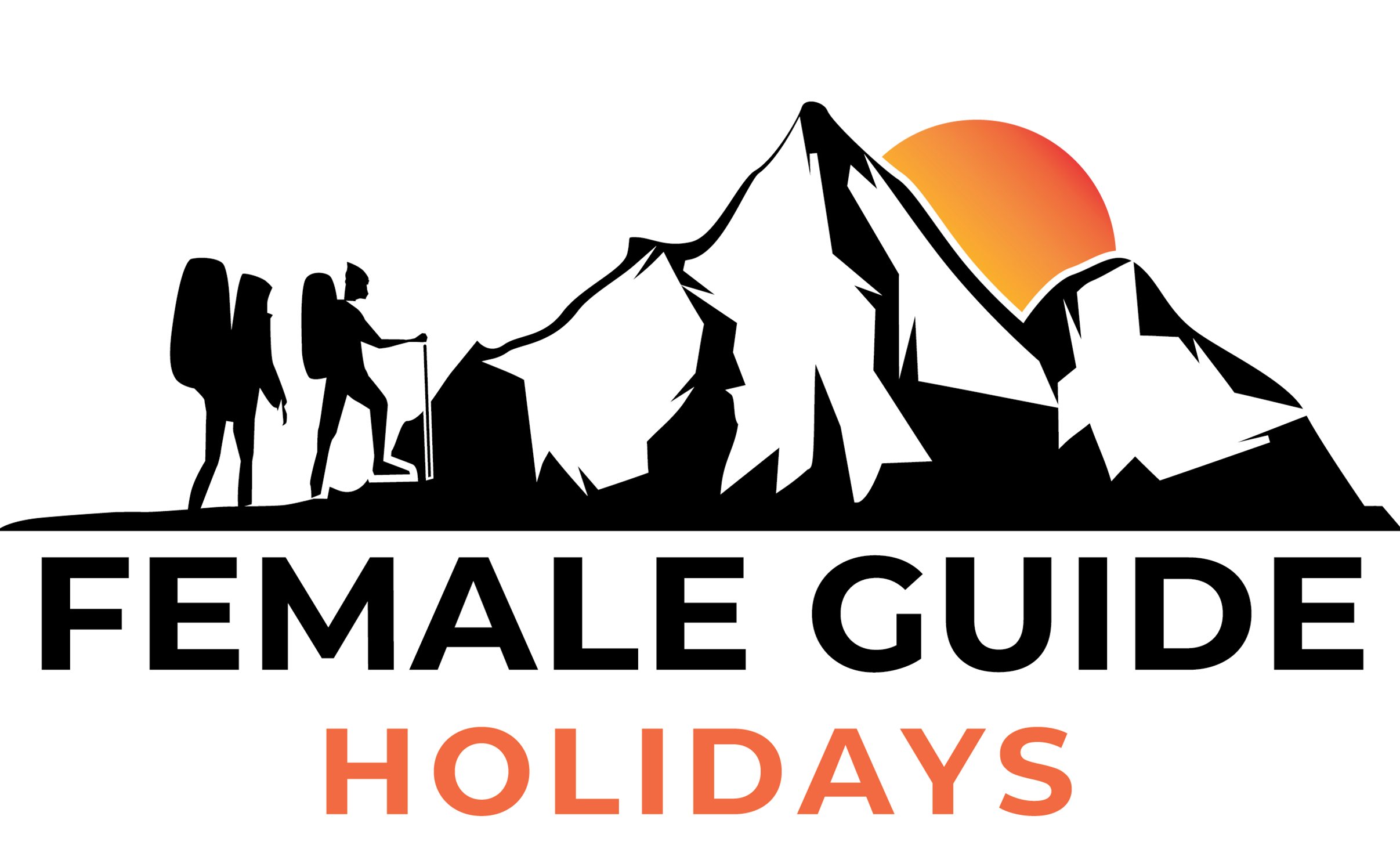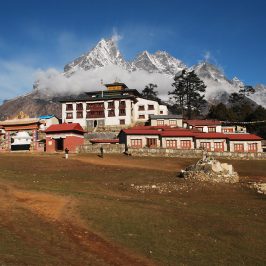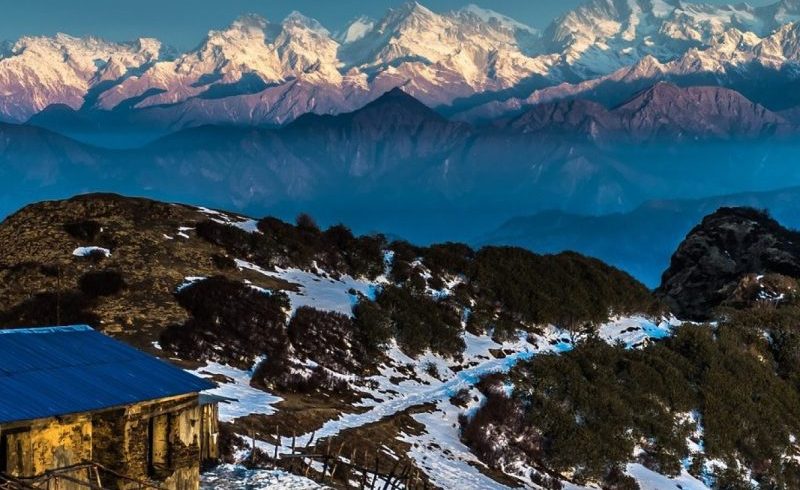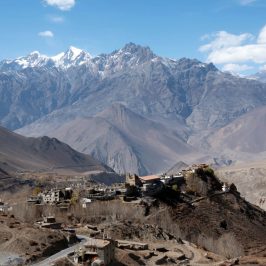Tengboche Monastery Trek is a short trek along the renowned traditional Everest trail to explore the largest and most famous monastery in Nepal’s Khumbu region, with a visit to Tengboche Monastery, also known as Dawa Choling Gompa, this 10-day adventure offers a glimpse of ethnic Sherpa heritage, culture, and tradition. For more information Click Here…..
Furthermore, close-up views of eight-thousanders like Everest and Lhotse, as well as others like Nuptse and Ama Dablam, add to the experience. The picturesque journey is enhanced by the Sagarmatha National Park’s rich subalpine flora and rare wildlife. This trail follows a section of the ancient Everest trekking trail.
Starting in Lukla, the path continues via Phakding hamlet and Namche Bazaar settlement, both on the Dudh Koshi river. The trip then continues to Tengboche village, where a visit to the monastery is scheduled. Finally, after retracing your steps back to Monjo, the journey comes to an end in Lukla. The Tengboche Monastery Trip is an easy to moderately difficult trek ideal for trekkers of all levels of physical fitness. The journey is mostly for individuals who wish to learn about the ethnic Sherpa culture and traditions on a simple yet adventurous, popular, and mountainous terrain.
Best Time to Travel & Weather Condition:
The ideal seasons for Everest Base Camp Helicopter Trek are spring (March to May) and fall (mid-September to November). During these seasons, the weather is dry and clear, making it perfect for trekking and basking in pristine mountain landscapes. The days are pleasant, while the evenings are cool. However, because these are peak seasons, the trails get crowded and busy.
The foothills are enchanting with wildflowers, especially rhododendron blossoms, in the spring. The Base Camp is transformed into a tented city during the climbing season, with climbers and Sherpa guides. Trekking to Everest Base Camp is extremely popular in the autumn, you may experience extremely clear sights during this season due to the ending of the heavy monsoon season, which clears the atmosphere.
If you plan your journey around October, you’ll be able to attend Mani Rimdu, the Everest region’s most significant festival, people from Tengboche, Chiwong, and Thame monasteries all participate in this celebration.
Entry Permits & Requirements:
The Everest Base Camp Helicopter Trek requires two permits:
1) Sagarmatha National Park Entry Permit and
2) Khumbu Rural Municipality Entrance Permit.
Unlike many Nepal Himalaya climbs, you won’t require a TIMS (Tourist Information Management System) card for this one.
The Nepal Tourism Board’s office in Kathmandu or the park’s entrance gate in Monjo can provide you with Sagarmatha National Park Entry Permit for NRS 3000.
The fee for citizens of SAARC nations is NRS 1500.
You must complete the permit application and present your passport or a copy of your passport. You must be in Lukla to obtain the Khumbu Pasang Lhamu Rural Municipality Entrance Permit. The permission costs NRS 2000 and may be acquired at the rural municipality counter on the outskirts of the settlement. You won’t have to worry about waiting for permits since the company or our guides will take care of everything.

Travel Insurance:
All clients participating in any activity must have travel insurance. The insurance plan will cover personal injury, death, hospital expenses, repatriation fees, helicopter rescue, and any other covered disease; we strongly recommend obtaining a comprehensive insurance plan from a reputable insurance company.
Passport and Visa:
Every client must have a valid passport from the return date with a 6 months prior validity by the Nepalese consulate in your country or immigration office at Tribhuvan International Airport in Kathmandu.
Equipment lists
- Find the guidelines regarding essential trekking gears.
- Daypack above 40 liters. (Must be waterproof)
- Down jacket (rental available)
- Warm sleeping bag (rental available)
- Sun head, gulf cap, sunglasses, headlamp, and torchlight.
- Ear-muffs, sun Lotions/sun cream.
- One pair of liner gloves is thin wool and synthetic.
- Cotton t-shirts, Synthetic t-shirt.
- Two Long sleeve polyester or synthetic lightweight for sunny days.
- One Soft-shell jacket water & wind resist.
- One swimming dress.
- Inner cloths as your requirement.
- Liner socks, woolen socks.
- Proper trekking shoes.
- Imodium or Pepto Bismo capsules for upset stomach or diarrhea.
- Diamox for altitude sickness. The guide will help you to take it.
- One small personal-sized first-aid kit with blister treatments such as moleskin, bands, anti-infection ointments, muscle relief ointments.
Meals and Drinking Water:
Tourist lodges and tea houses in popular trekking areas like Annapurna, Everest, Langtang, and Manaslu offer a menu system featuring various ethnic cuisine foods alongside Western dishes, but some places serve authentic Nepali meals, distinct from international fare, with local cooks preparing these meals while ensuring cleanliness, hygiene, freshness, and deliciousness; each lodge provides safe drinking water or mineral water. If you buy a water purification tablet from Kathmandu you can take water from the tap and purify it by yourself, this will be cheaper and control plastic pollution as well.
Itinerary
The flight into Kathmandu Valley is breathtaking with a panoramic view of the Himalayan ranges and the valley below. A representative will meet you at Tribhuvan International Airport and drive you to your accommodation.
Walking Distance: 4-5 hours (6 km) trek Enjoy an entire day at Namche Bazaar. This is your first day of acclimatization, as you ascend, your body must acclimate to the thinner air at greater elevations. The village has various vantage points for an acclimatization hike. An early morning hike at any vantage point will provide you with a breathtaking view of the Himalayas. The sun's rays illuminate the snow-covered peaks of Mount Everest, Ama Dablam, Thamserku, Kongde, and Lhotse. Explore the Sherpa Culture Museum to learn about Sherpa culture and customs. An upward hike from Shyangboche Airport to Everest View Hotel provides an excellent acclimatization hike while offering close-up views of Mount Everest, Thamserku, and Ama Dablam. You could hike to Khumjung and Kunde settlements if you want to or visit Sir Edmund Hillary's school, first in the Everest Region at Khumjung. Khumjung Monastery, which is almost 400 years old, has what is said to be the scalp of Yeti, the abominable snowman.




